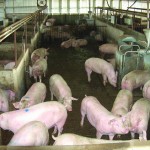High replacement rates for first- and second-parity sows have skewed current parity structures on many sow farms towards younger, less productive females, Dr. Billy Flowers of North Carolina State University told the recent Banff Pork Seminar. He said that as a result, herd productivity is being limited because females are culled before they reach their

Understanding factors affecting sow longevity
A speaker at the Banff Port Seminar analyzes the differences between two farms with different average longevities
Be realistic about replacement rate
Peet on Pigs
There is a popular misconception that replacing about one-third of a sow herd each year is a good target, despite the fact that I rarely see or hear of a herd achieving it. This probably stems back to the dim and distant past when sows were less productive and rather more hardy than today’s high-octane
Immunological castration boosts profit by $5 per hog
Peet on Pigs
An independent study shows significant gains for producers using alternative to conventional castration
Apanel of independent U.S. economists has found producers who use immunological castration (IC) can generate a potential increase of $5.32 per head over conventionally castrated barrows. The benefit is primarily derived from being able to market the treated pigs at a heavier carcass weight, an increase in feed efficiency, and cost saving from not having
Electronic sow feeding first choice for productivity
When considering group sow-housing systems, electronic sow feeding (ESF) is likely the best choice for pig producers with high productivity expectations, according to Thomas Parsons at the University of Pennsylvania. “We now have farms pushing above 30 pigs weaned per sow per year and thus the technology itself, if properly managed, is not a barrier
Optimizing the use of energy in pig feeds
With the cost of dietary energy more than doubling in the last eight years, it’s vitally important to optimize the efficiency with which it is utilized. Meeting the energy specifications of a typical grower diet now represents about 85 per cent of the cost of the diet and over 50 per cent of the total
There are many ways to improve farrowing rates
There’s a large variation in farrowing rate between farms, ranging from as low as 75 per cent to around 92 per cent. Many producers still view 85 per cent as being an acceptable target and figure it can’t be improved much further. But close attention to a range of management factors can often result in
Continued uncertainty for hog producers in 2013
After a six-year period of poor profitability, Canadian producers are on a knife edge, especially those in the West. With the hog price at around $1.45 and production costs of at least $170 per hog, they have been bleeding cash over the winter. And now the latest census data suggests that the supply of hogs
Feed withdrawal saves costs and contamination
Not withdrawing feed for a period prior to shipping market hogs can cost up to $5 per head, according to Dr. Eduardo Beltranena of Alberta Agriculture and Rural Development. Not only that, he says, it can also increase transportation losses and compromise pork safety. However, while packer contracts stipulate that feed withdrawal should be carried
Managing the transition to group sow housing
There is now a growing acceptance in the Canadian pork industry that producers must eventually move away from sow stalls and towards group housing. When the new welfare codes of practice are released this summer, they will likely require that no new stall housing is built after 2014 and that existing facilities are converted to
Getting the most from herd-recording data
Banff speaker outlines key factors which he believes make the biggest contribution to the number of quality pigs weaned per sow.
There are literally dozens of different swine herd-recording programs. Most producers use a computer-based system to monitor performance, but do producers extract maximum value from their data? Ron Ketchem, a partner in Swine Management Services of Fremont, Nebraska, thinks not. Speaking at the Banff Pork Seminar, he described how his company analyzes data from more
